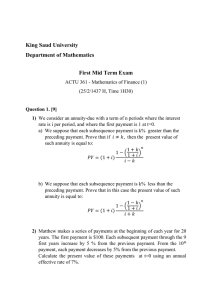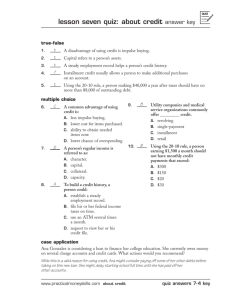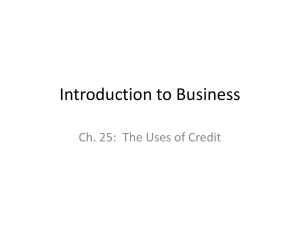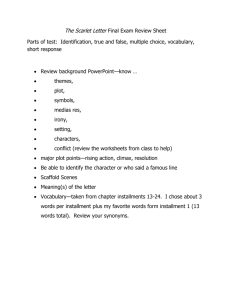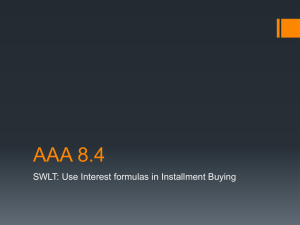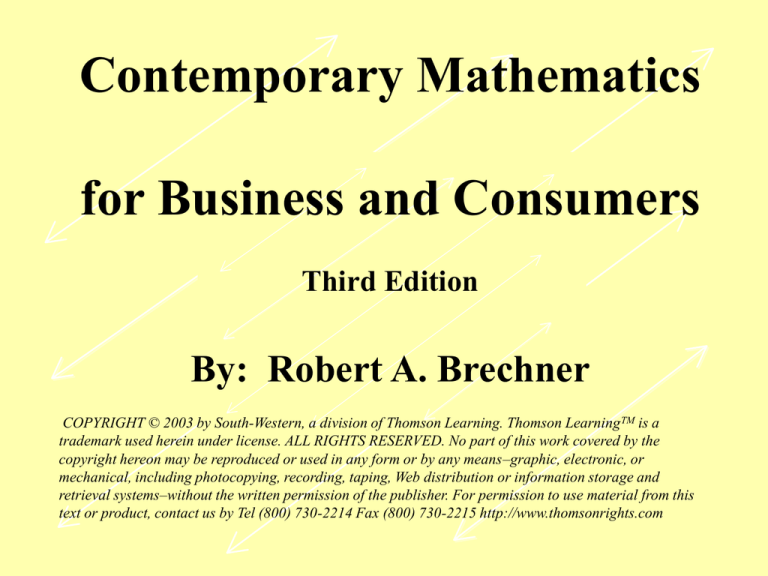
Contemporary Mathematics
for Business and Consumers
Third Edition
By: Robert A. Brechner
COPYRIGHT © 2003 by South-Western, a division of Thomson Learning. Thomson Learning TM is a
trademark used herein under license. ALL RIGHTS RESERVED. No part of this work covered by the
copyright hereon may be reproduced or used in any form or by any means–graphic, electronic, or
mechanical, including photocopying, recording, taping, Web distribution or information storage and
retrieval systems–without the written permission of the publisher. For permission to use material from this
text or product, contact us by Tel (800) 730-2214 Fax (800) 730-2215 http://www.thomsonrights.com
Chapter 13
Consumer and Business Credit
Copyright © 2003 by South-Western
Chapter 13, Consumer and Business Credit
Section I Open – End Credit – Change
Accounts, Credit Cards, and Lines of Credit
13-1 Calculating finance charge and new balance
by the unpaid or previous month’s balance
method.
13-2 Calculating finance charge and new balance
using the average daily balance method.
13-3 Calculating the finance charge and new
balance of business and personal lines of credit.
Chapter 13, Consumer and Business Credit
(Cont.)
Section II Closed – End Credit Installment
Loans
13-4 Calculating the total deferred payment price
and the amount of the finance charge of an
installment loan.
13-5 Calculating the amount of the regular
monthly payments of an installment loan by
formula.
13-6 Calculating the annual percentage rate of an
installment loan by APR tables and by formula.
Chapter 13, Consumer and Business Credit
(Cont.)
Section II Closed – End Credit Installment
Loans
13-7 Calculating the finance charge and monthly
installment loan by using the APR tables
installment loan.
13-8 Calculating the finance charge rebate and the
amount of the payoff when a loan is paid off early
by using the sum – of – years – digits method.
Section I, Open – End Credit – Charge Accounts,
Credit Cards, and Lines of Credit
Revolving Credit
Interest = Principal x Rate x Time
13-1 Calculating Finance Charge and ?New Balance by
the Unpaid or Previous Month’s Balance Method
Steps to Calculate the Finance Charge and new Balance by Using the
Unpaid balance Method:
Step 1. Divide the annual percentage rate by 12 to find the monthly or
periodic interest rate. (Round to the nearest hundredth percent when
necessary.
Periodic rate = Annual percentage rate
12
Step 2. Calculate the finance charge by multiplying the previous
month’s balance by the periodic interest rate from Step 1.
Finance charge = Previous month’s balance x Periodic rate
13-1 Calculating Finance Charge and New Balance by the
Unpaid or Previous Month’s Balance Method (Cont.)
Steps to Calculate the Finance Charge and new Balance by
Using the Unpaid balance Method:
Step 3. Total all the purchases and cash advances for the
month.
Step 4. Total all the payments and credits for the month.
Step 5. Use the following formula to determine the new
balance:
New Balance = Previous balance + Finance Charge
+ Purchases and Cash advances - Payments
13-2 Calculating Finance Charge and New Balance by
Using the Average Daily Balance Method
Steps to Calculate the Finance Charge and New Balance by
Using the Average Daily Balance Method:
Step 1. Starting with the previous month’s balance s the
first unpaid balance, multiply each by the number of days
that the balance existed, until the next account transaction.
Step 2. At the end of the billing cycle, find the sum of all
the daily balance figures.
Step 3. Find the average daily balance using the formula
Average daily balance = Sum of daily balance
Days in billing cycle
13-2 Calculating Finance Charge and New Balance by
Using the Average Daily Balance Method (Cont.)
Steps to Calculate the Finance Charge and New Balance by
Using the Average Daily Balance Method:
Step 4. Calculate the finance charge by
Finance Charge = Average daily balance x Periodic rate
Step 5. Compute the new balance as before, using
New balance = Previous balance + finance charge +
Purchases and cash advances - Payments
Everybody’s Business
“New Balance” can be calculated by adding the
finance charge to the last “Unpaid Balance” of the
month.
$427.28 + $3.89 = $431.37
Section II, Closed – End Credit – Installment
Loans
13-4 Calculating the Total Deferred Payment Price and the
Amount of the Finance Charge of an Installment Loan
Amount Financed = Purchase price – Down payment
Down payment = Purchase price x Down payment
percent
Total amount of installment payments = Amount
financed + finance charges
Section II, Closed – End Credit – Installment
Loans (Cont.)
13-4 Calculating the Total Deferred Payment Price and the
Amount of the Finance Charge of an Installment Loan
Finance charge = Total amount of installment
payments – Amount financed
Total amount of Installment payment = Monthly payment
amount x Number of Monthly payment
Total deferred payment price = Total of installment
payments + Down payment
13-5 Calculating the Amount of Regular Monthly
Payments of an Installment Loan by adding the Add-on
Interest Method
Steps to Calculate the Monthly Payment Using the Add-On
Interest:
Step 1. Calculate the amount to be financed by subtracting
the down payment from the purchase price.
Amount financed = Purchase price (100%) – Down
payment percent)
Step 2. Compute the add-on interest charge by using I =
PRT.
13-5 Calculating the Amount of Regular Monthly
Payments of an Installment Loan by adding the Add-on
Interest Method (Cont.)
Steps to Calculate the Monthly Payment Using the Add-On
Interest:
Step 3. Find the Total of installment payments by adding the finance
charge to the amount financed.
Total of installments payments = Amount financed + finance
charges
Step 4. Find the regular payments by dividing the total of installment
payments by the number of months of the loan.
Regular monthly payments = Total of installment payments
Number of months of the loan
Everybody’s Business
As with open-end credit, installment loan
consumers are protected by Regulation Z of the
Truth in Leading Act.
Advertisers of installment loans such as car
dealers and furniture stores, must disclose in the
ad and the loan agreement the following
information:
Down payment
Annual percentage rate
Terms and payments Total payback
13-6 Calculating the Annual Percentage Rate of an
Installment Loan by APR Tables and by Formula
Steps to Find the Annual Percentage Rate of an Installment
Loan Using APR Tables
Step 1. Calculate the finance charge per $100 by
Finance charge per $100 = Finance charge x 100
Amount financed
Step 2. From the Table 13-1, scan down the Number of Payments
column to the number of payments for the loan in question.
Step 3. Scan to the right in that Number of Payments row to the table
that most closely corresponds to the finance charge per $100 calculated
in Step 1.
Step 4. Look to the top of the column containing the finance charge
per $100 to find the APR of the loan.
13-7 Calculating the Finance Charge and Monthly
Payment of an Installment Loan by Using the APR Tables
Steps to Find the Finance Charge and Monthly Payment of
an Installment Loan by Using the APR Tables
Step 1. Using the APR and the number of payments of the loan, locate
the table factor at the intersection of the APR column and the number
of payments row. This factor represents the finance charge per $100
financed.
Step 2. The total finance charge of the loan can be found by
Finance charge = Amount financed x Table factor
100
Step 3. The monthly payment can now be found by
Monthly payment = Amount financed + finance charge
Number of Months of the Loan
Chapter 13, Consumer and Business Credit
Open – end credit
Annual percentage rate (APR
Secured loan
Billing cycle
Line if credit
Install loan
Down payment
Amount financed
Finance charge rebate
Rebate fraction
Finance charge
Unsecured loan
Revolving credit
Average daily balance
Prime rate
Mortgage
Cash or purchase price
Add-on interest
Rule of 78
Chapter 13
Periodic rate =
Annual percentage rate
12
Finance charge = Previous month’s balance x Periodic rate
Average daily balance =
Sum of daily balances
Days in billing cycle
Finance charge = Average daily balance x Periodic rate
New
balance =
Previous
Finance
Purchases and
Payments
balance + charge + cash advances = & credits
Copyright © 2003 by South-Western
Chapter 13
Amount financed = Purchase price - Down payment
Down payment = Purchase price x Down payment percent
Amount
financed
=
Purchase price(100% - Down payment %)
Total amount of = Amount financed + Finance charge
installment payments
Finance charge =
Total amount of - Amount financed
installment payments
Copyright © 2003 by South-Western
Chapter 13
Total amount of =
installment payments
Monthly payment x Number of
amount
monthly payments
Total deferred pmt. Price = Total of install pmts. + Downpmt.
Interest
= Principal
x
(finance charge) (amount financed)
Rate x Time
Regular monthly payments = Total of installment payments
Number of months of loan
72 I
APR
3 P ( n 1) I ( n 1)
Copyright © 2003 by South-Western
Chapter 13
Finance charge =
Amount financed x APR table factor
100
Sum of digits = n(n + 1)
2
Rebate fraction =
Sum of digits of remaining payments
Sum of digits of total payments
Finance charge rebate = Rebate fraction x Total finance charge
Loan payoff =
(Payments remaining x Pmt amount) - Finance charge rebate
Copyright © 2003 by South-Western

